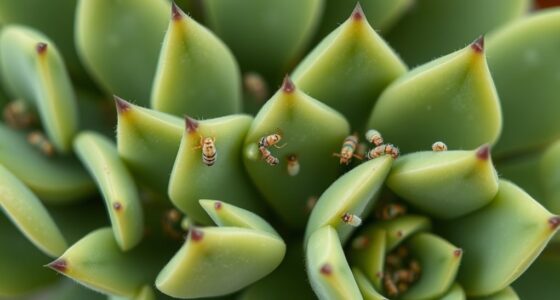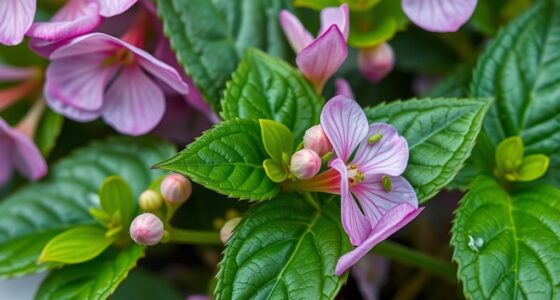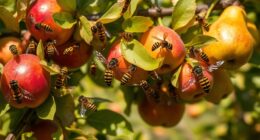To manage broad mites on African violets, start by inspecting your plants regularly with a magnifier for early signs like distorted or stippled leaves. Maintain proper spacing, good hygiene, and avoid overcrowding to reduce mites’ spread. Use organic options like neem oil or insecticidal soaps, or introduce predatory mites for natural control. Quarantine infected plants immediately. By following these steps, you can keep your violets healthy—discover more strategies to prevent future infestations.
Key Takeaways
- Regularly inspect plants with magnifying tools to detect early mite signs and prevent widespread infestation.
- Maintain proper plant spacing, hygiene, and sanitation to reduce mite habitat and encourage healthy growth.
- Use organic treatments like neem oil or insecticidal soaps promptly upon mite detection.
- Introduce natural predators, such as predatory mites, to biologically control broad mite populations.
- Quarantine and thoroughly inspect new or infected plants to prevent spreading mites to healthy plants.
Recognizing the Signs of Broad Mite Infestation
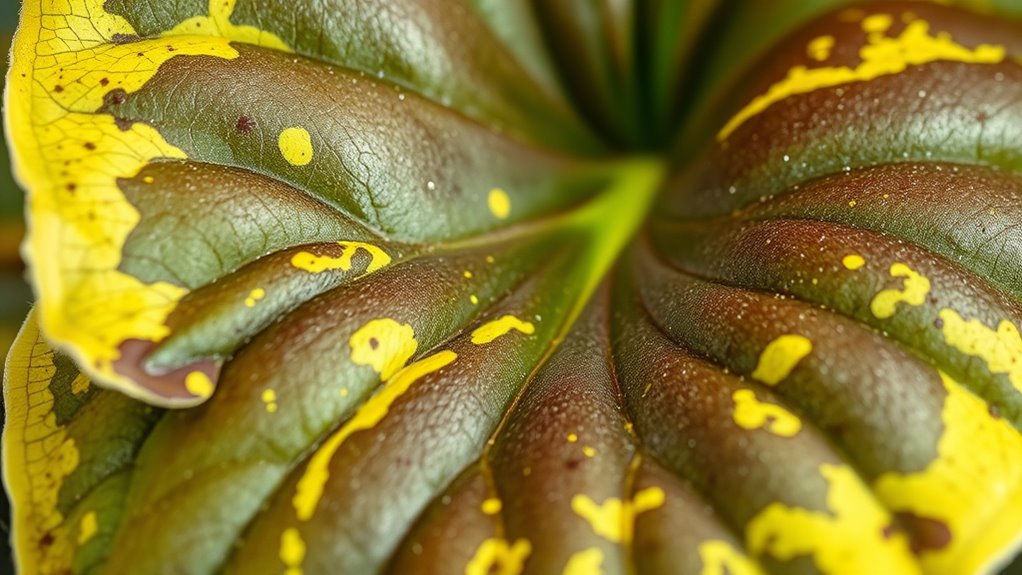
Recognizing the signs of broad mite infestation early is essential to protect your African violets. Proper pest identification helps you catch problems before they worsen. Look closely at your plants for subtle changes, such as distorted or curled leaves, which can be mistaken for other issues. Symptom differentiation is key—broad mites often cause a fine, silvery or stippled appearance on leaf surfaces, along with new growth that appears deformed or stunted. You might notice a decline in plant vigor, with leaves turning yellow or browning prematurely. Since these mites are tiny and hard to see with the naked eye, inspecting the undersides of leaves regularly can reveal their presence. Early detection through careful observation allows you to act swiftly and prevent serious damage. Additionally, understanding AI security measures can help develop more effective pest monitoring systems that alert you to infestations at an early stage.
Understanding the Life Cycle of Broad Mites

Understanding the life cycle of broad mites is essential for effective management because it reveals how quickly they can reproduce and spread on your African violets. These tiny pests develop rapidly, with eggs hatching in 2-3 days, leading to new generations in just a week. To disrupt their cycle, maintain proper soil aeration, which discourages mite buildup in the substrate. Using pest-resistant varieties can also reduce infestations. Broad mites go through four stages: egg, nymph, protonymph, and adult, each lasting about 2-3 days. Their quick reproduction means you must act swiftly once signs appear. The table below summarizes their development:
| Stage | Duration | Key Characteristics |
|---|---|---|
| Egg | 2-3 days | Tiny, oval, sticky |
| Nymph | 2-3 days | Mite size, mobile |
| Protonymph | 2-3 days | Developing legs |
| Adult | 4-5 days | Reproductive, mobile |
Monitoring environmental conditions such as humidity and temperature can also help prevent rapid mite proliferation which is crucial for control.
Common Causes and Risk Factors for Infestation
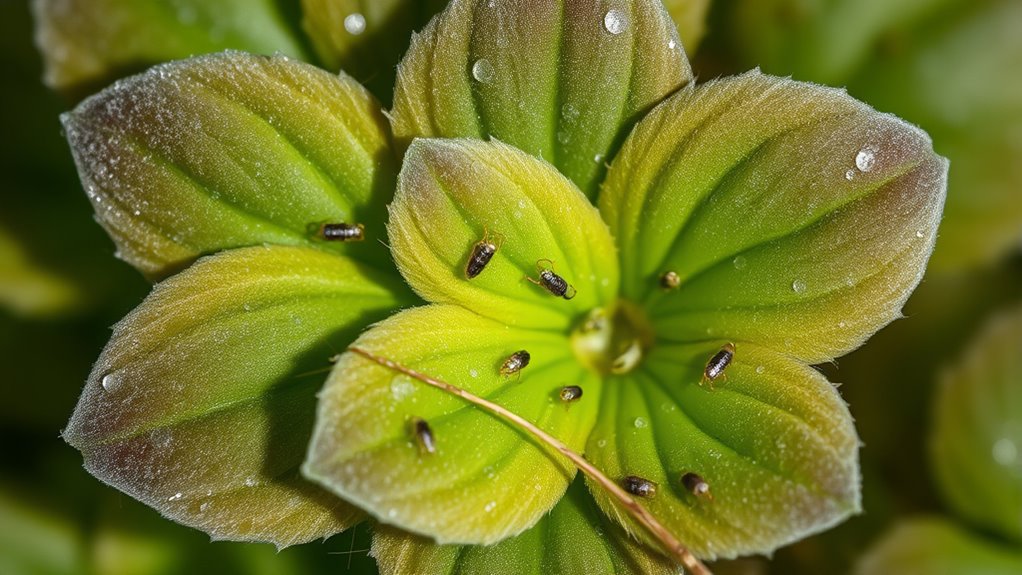
You’re more likely to face broad mite infestations when your plants are overcrowded or lack proper airflow. Poor hygiene, like dirty leaves or tools, can also invite these pests. Additionally, bringing in infected plants increases the risk of spreading mites to your healthy African violets. Using color accuracy in your plant care routines can help you better identify early signs of infestation and prevent further issues.
Overcrowded Growing Conditions
Overcrowded growing conditions substantially increase the risk of broad mite infestations on African violets. When plants are kept in cramped spaces, it’s easier for mites to spread quickly from one plant to another. Crowded growth limits airflow and creates humid, damp environments that favor mite reproduction. Overcrowded conditions also make it harder to spot early signs of infestation since plants are pressed close together. The lack of space encourages stressed plants, which are more vulnerable to pests. To reduce the risk, give your African violets enough room to grow comfortably, ensuring proper spacing between plants. Maintaining good airflow and avoiding overcrowded conditions helps prevent broad mite populations from taking hold and spreading throughout your collection. Additionally, recognizing the importance of plant health and resilience can help you implement preventative measures more effectively.
Poor Plant Hygiene
Poor plant hygiene is a common factor that increases the risk of broad mite infestations on African violets. When you neglect regular cleaning, pests can thrive on debris and infected plant material. Soil sterilization is essential before planting or repotting to eliminate hidden mites and eggs. Using pest resistant varieties can also help reduce vulnerability, but only if the plants are kept healthy and clean. Keep your plants free of dead leaves, dust, and debris, which provide hiding spots for mites. Avoid reusing potting soil without proper sterilization, as contaminated soil can harbor pests. Consistent hygiene practices, including sterilizing tools and cleaning your growing area, create an environment less hospitable to mites and markedly lower infestation risks. Additionally, implementing proper spraying techniques with suitable tools can help control mite populations and prevent outbreaks.
Infected Plant Sources
Infected plants are a primary source of broad mite infestations, often entering your collection through new acquisitions or shared containers. These plants may harbor mites before symptoms appear, making early detection essential. To reduce risk, inspect new plants carefully, especially those with poor plant nutrition, which can weaken defenses. Avoid sharing containers or potting materials that might carry mites. Choose pest resistant varieties when possible, as they’re less likely to become infested. Ensuring good plant health through proper nutrition helps plants resist mite attacks. Be cautious with plants from unreliable sources, and quarantine new additions for a few weeks. Keeping an eye on plant condition and maintaining hygiene minimizes the chances of introducing broad mites into your collection. Proper plant hygiene is also crucial in preventing mite spread and maintaining healthy African violets.
Effective Monitoring Techniques for Early Detection

To catch broad mites early, you should inspect your plants regularly for any unusual symptoms. Use a magnifying glass to spot tiny pests or damage that might not be visible to the naked eye. Keep a close watch for changes in leaf color, texture, or growth patterns, which can signal an infestation. Additionally, familiarize yourself with common pest identification techniques to distinguish broad mites from other pests.
Regular Plant Inspections
Regular plant inspections are essential for catching broad mite infestations early before they cause significant damage. By regularly checking your African violets, you can notice subtle signs like speckling or distorted leaves. During inspections, incorporate pruning techniques to remove affected foliage and improve airflow, reducing mite hiding spots. Use your hands or a small brush to gently feel leaf surfaces for tiny pests. Also, examine the soil and consider soil amendments that promote plant health, making plants more resistant to pests. Regular inspections help you identify issues before they escalate, saving time and plant health. Remember to check under leaves, around stems, and at the base of plants. Consistent monitoring ensures prompt action, keeping your violets healthy and vibrant. Being aware of regional pest prevalence can help you anticipate and prevent infestations more effectively.
Use of Magnifying Tools
Using magnifying tools is one of the most effective ways to detect broad mites early on your African violets. These tools allow you to closely examine leaves and stems for tiny pests that are often invisible to the naked eye. With magnifying tools, you can quickly identify signs of infestation and perform accurate insect identification, which is vital for selecting appropriate control measures. Regular use of a hand lens or microscope helps you spot mites before they cause significant damage, saving your plants from severe stress. Proper inspection techniques enhance detection accuracy and ensure you catch infestations early. Keep in mind that early detection through careful inspection with magnifying tools enhances your ability to manage broad mites effectively. This proactive approach allows you to act swiftly and prevent the spread of pests throughout your collection.
Monitoring Symptoms Changes
Monitoring symptom changes is a crucial step in catching broad mite infestations early. By regularly observing your African violets, you can identify subtle signs before damage becomes severe. Pay close attention to leaf curl, speckling, or discoloration, which may indicate mite activity. Changes in plant nutrition, like yellowing or stunted growth, can also signal stress from pests. Keep environmental humidity consistent; fluctuations can promote mite reproduction. Use a magnifying tool to spot tiny pests or eggs. Also, monitor for uneven watering or nutrient deficiencies, as these can mimic mite damage. Consistent observation helps you detect early symptoms, allowing prompt treatment and healthier plants. Being aware of plant health indicators can improve your ability to identify issues early. Staying vigilant ensures you catch issues early, reducing the risk of widespread infestation.
Cultural Practices to Prevent Broad Mite Problems
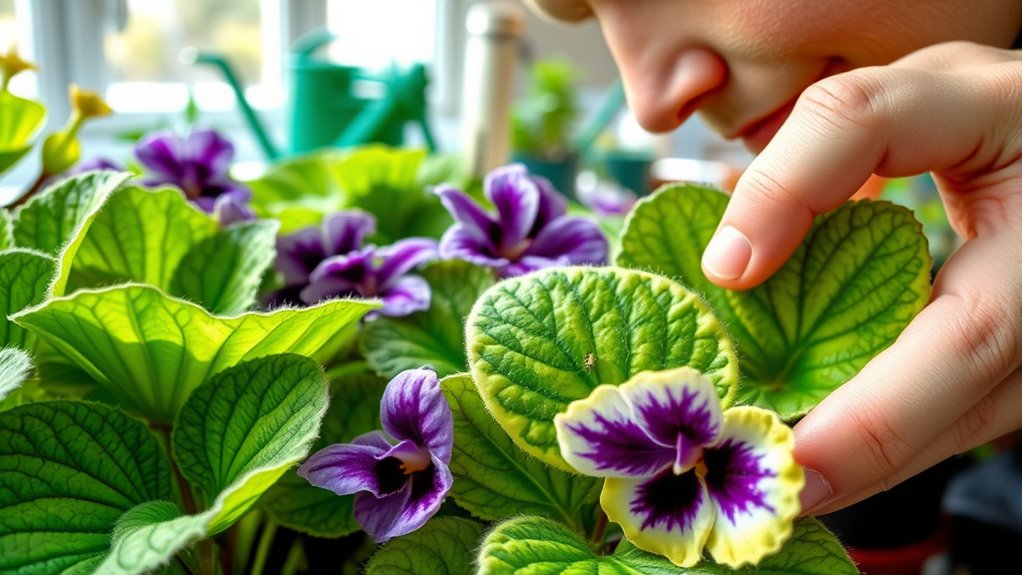
Preventing broad mite infestations begins with maintaining healthy, vigorous African violets. Start by using proper soil amendments to improve drainage and nutrient availability, which strengthen plant defenses. Avoid overly rich or poorly draining soil that can weaken plants and attract pests. Establish consistent watering schedules, ensuring you don’t overwater or underwater, as stressed plants are more susceptible to mites. Water deeply when needed, allowing the soil to dry slightly between watering sessions. Keep humidity levels moderate and avoid excess moisture on foliage, which can promote mite attraction. Regularly inspect your plants for early signs of trouble, and remove any debris or fallen leaves promptly. These cultural practices create an environment less inviting to broad mites, helping you keep your African violets healthy and pest-free.
Organic and Chemical Treatment Options
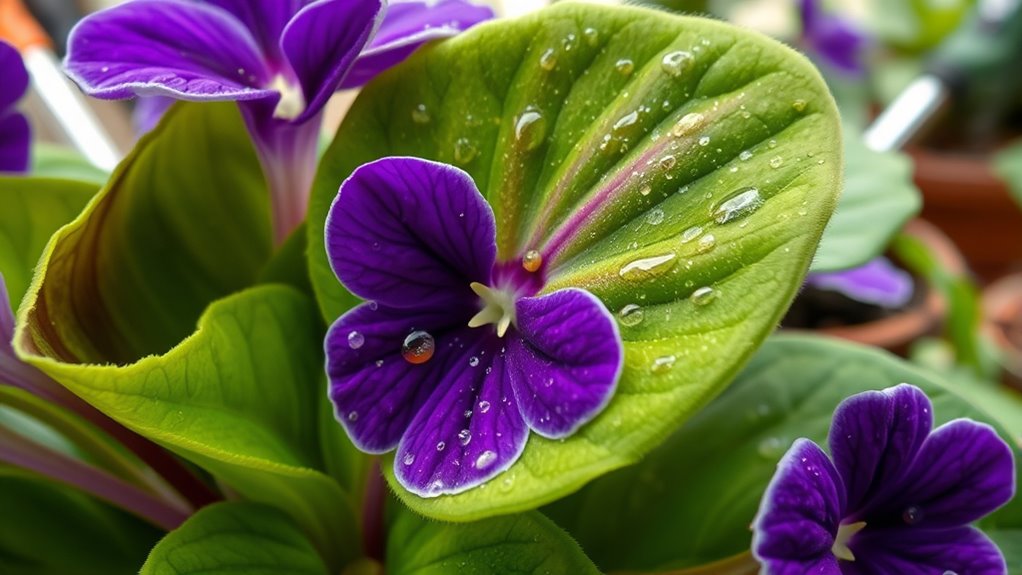
When it comes to treating broad mite infestations on African violets, you have both organic and chemical options to choose from. Organic treatments include organic repellents like neem oil and insecticidal soaps, which can help deter mites without harming your plant. You might also consider introducing natural predators, such as predatory mites, to naturally reduce mite populations. Chemical options include miticides specifically formulated for broad mites; always follow instructions carefully to avoid damage. Keep in mind that combining organic repellents with biological approaches can be effective. Be cautious with chemical treatments, especially on delicate plants like African violets. Regular monitoring is essential to catch infestations early and select the most appropriate treatment method for your plant’s health.
Implementing Biological Controls for Mite Management
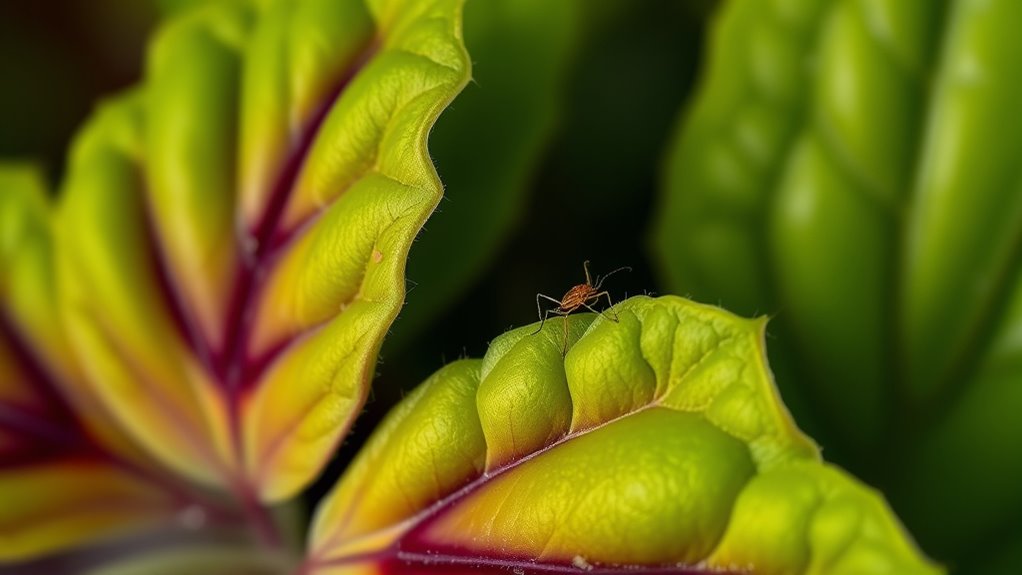
Implementing biological controls can be an effective way to manage broad mite infestations on African violets, especially when used alongside other treatment methods. Introducing beneficial insects, like predatory mites, can naturally reduce mite populations without chemicals. These insects target broad mites directly, helping to keep the infestation under control. You can also enhance their effectiveness by using soil amendments that encourage healthy plant growth and support beneficial insect populations. Healthy plants are more resistant to pests, and soil amendments improve soil health, making the environment less favorable for mites. Regularly releasing beneficial insects and maintaining ideal soil conditions form a sustainable, eco-friendly approach. This integrated strategy minimizes chemical use and promotes a balanced ecosystem around your African violets.
Properly Quarantining and Handling Infected Plants
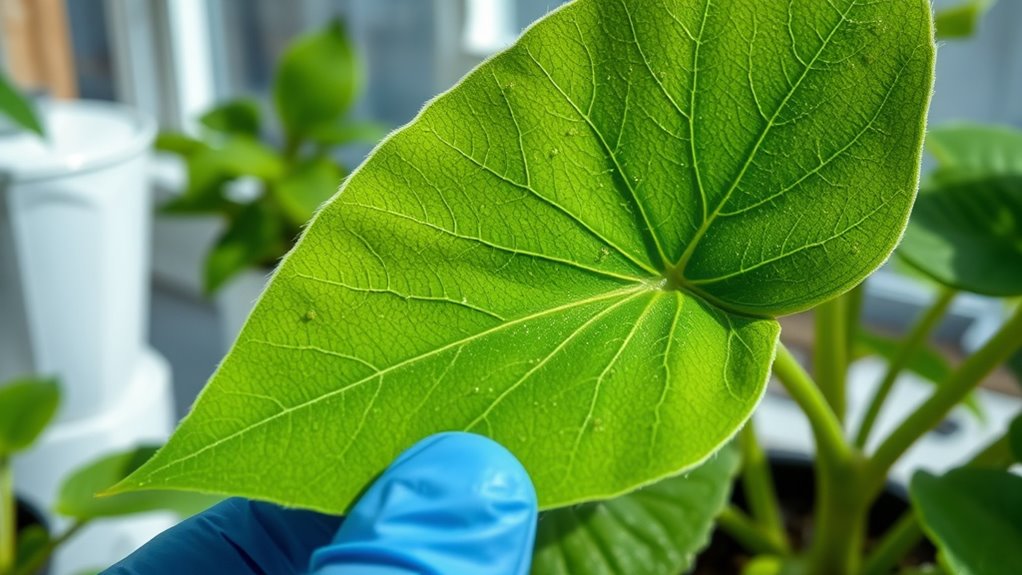
After establishing biological controls, it’s important to address how you manage plants showing signs of infestation. Quarantining infected plants prevents mites from spreading. Isolate affected plants in a separate area with good airflow and minimal contact with healthy ones. When managing infected plants, wear gloves and disinfect tools to avoid cross-contamination. Check soil amendments and ensure proper plant nutrition to boost resilience, but avoid overwatering, which can worsen mite issues. Regularly inspect quarantined plants for signs of mite activity before reintroducing them. Keep humidity levels low, as high humidity can encourage mite reproduction. Proper handling and strict quarantine protocols help control the infestation and protect your healthy African violets from further damage.
Long-term Strategies for Maintaining Healthy African Violets

Maintaining healthy African violets over the long term requires a proactive approach that emphasizes consistent care and preventive practices. Start by improving soil quality with appropriate soil amendments to assure proper drainage and nutrient availability, reducing stress and vulnerability to pests. Lighting optimization is also vital; provide bright, indirect light to promote healthy growth and flowering. Avoid overexposure, which can weaken plants, or insufficient light, which hampers development. Regularly inspect your violets for early signs of stress or pests, and adjust your care routine accordingly. Keep the environment clean to prevent mite infestations. By combining soil amendments and proper lighting, you create a robust growing environment that helps your violets resist pests and flourish over time.
Frequently Asked Questions
How Can I Differentiate Broad Mites From Other Pest Infestations?
To differentiate broad mites from other pests, start with a thorough visual inspection of your plants. Look for tiny, translucent or yellowish mites, often hidden on the undersides of leaves or in new growth. Mite identification can be tricky, but these pests cause distorted, stunted growth and speckled foliage. Comparing these signs with other pests helps you accurately identify broad mites, so you can take targeted action quickly.
Are There Specific African Violet Varieties More Resistant to Broad Mites?
You might wonder if certain African violet varieties resist broad mites better. While no cultivar is completely immune, resistant varieties and careful cultivar selection can help reduce your risk. Look for plants with strong, healthy foliage and avoid those with existing damage. Regularly inspect your violets, and choose cultivars known for their resilience. This proactive approach strengthens your plant’s defenses and minimizes mite infestations.
What Are the Most Cost-Effective Methods for Small-Scale Growers?
Imagine a gardener’s steady hand guiding delicate blooms through a storm. You can keep broad mites at bay cost-effectively by combining biological control with cultural practices. Introduce natural predators like predatory mites, and maintain cleanliness, proper watering, and good airflow. These methods work together, reducing mite populations naturally without costly chemicals, making them ideal for small-scale growers seeking sustainable, affordable solutions that protect their cherished African violets.
How Does Environmental Humidity Influence Broad Mite Populations?
Higher humidity levels can boost broad mite populations, making humidity control essential. By maintaining a low vapor pressure deficit, you reduce the stress on your plants and limit mite reproduction. Consistently monitoring and adjusting humidity helps prevent conditions that favor mites, keeping your African violets healthier. Proper humidity management creates an environment less conducive to mite proliferation, ensuring your plants stay vibrant and pest-free.
Can Natural Predators Completely Eliminate Broad Mite Infestations?
While biological control offers a natural approach, it won’t completely eliminate broad mite infestations on its own. You need to accurately identify the pest first, as pest identification is vital for choosing the right predators. Natural predators can reduce mite populations considerably, but they often work best alongside other control methods. Rely on proper pest identification and integrate biological control for more effective, sustainable management of broad mites.
Conclusion
By staying vigilant and using integrated management strategies, you can keep broad mites at bay and guarantee your African violets thrive. Regular monitoring and prompt action are key—did you know that early detection can reduce mite populations by up to 90%? With consistent care and proactive steps, you’ll enjoy healthy, beautiful plants for years to come. Take control now, and your violets will thank you with vibrant blooms.



